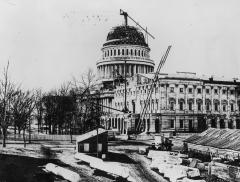For the Architect of the Capitol, sustainability – ensuring we are improving the future by the actions we take today – is something incorporated into our everyday thinking.
At the AOC, sustainable practices include, among others, improving energy and water efficiency, using low-impact materials, promoting health and wellness, sustaining our natural sites, and practicing comprehensive recycling and providing sustainability guidance to divisions across Capitol Hill. From the very beginning, choices made in the design, construction, and maintenance of the U.S. Capitol and the surrounding facilities fit within many of the modern standards defining sustainable practices.
This work extends well beyond the Capitol. For example, the United States Botanic Garden (a jurisdiction of the AOC) is a partner in the Sustainable Sites Initiative, an interdisciplinary effort led by the American Society of Landscape Architects, the Lady Bird Johnson Wildflower Center, and the Botanic Garden, to develop the first national guidelines and performance benchmarks for landscapes and gardens.
The AOC is working in many different areas, from small efforts, such as installing thousands of compact florescent lights across the Capitol campus. Larger initiatives include the implementation of Energy Savings Performance Contracts – public/private partnerships in which a selected vendor invests money in energy savings projects and is repaid based on the verified energy savings.







